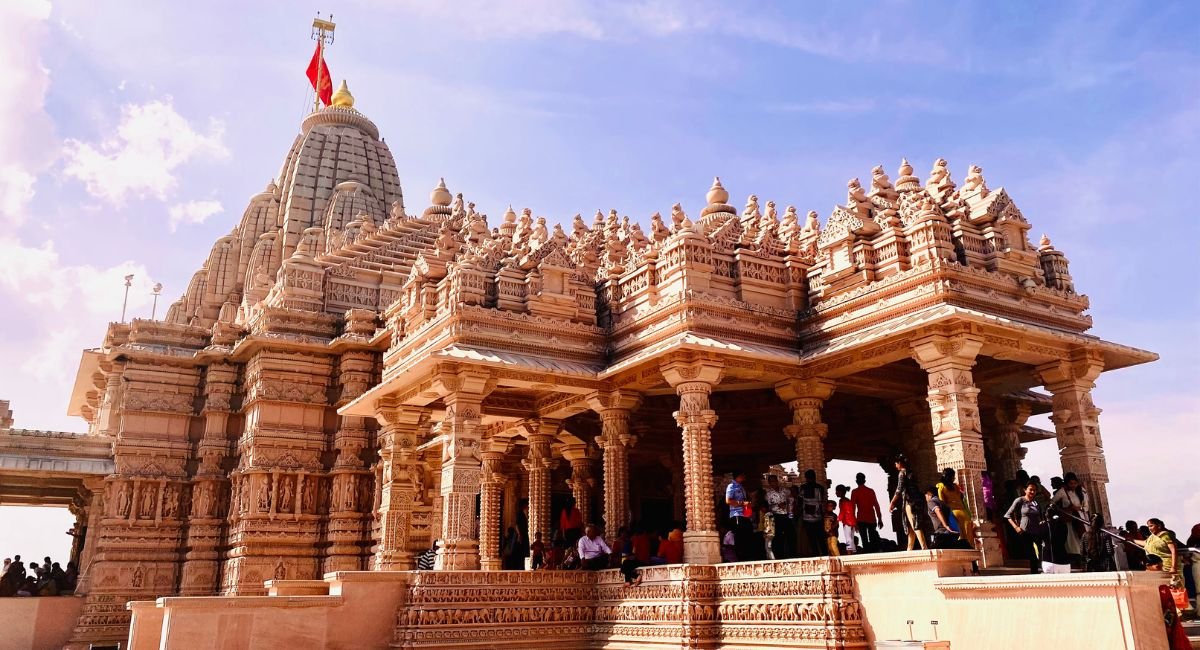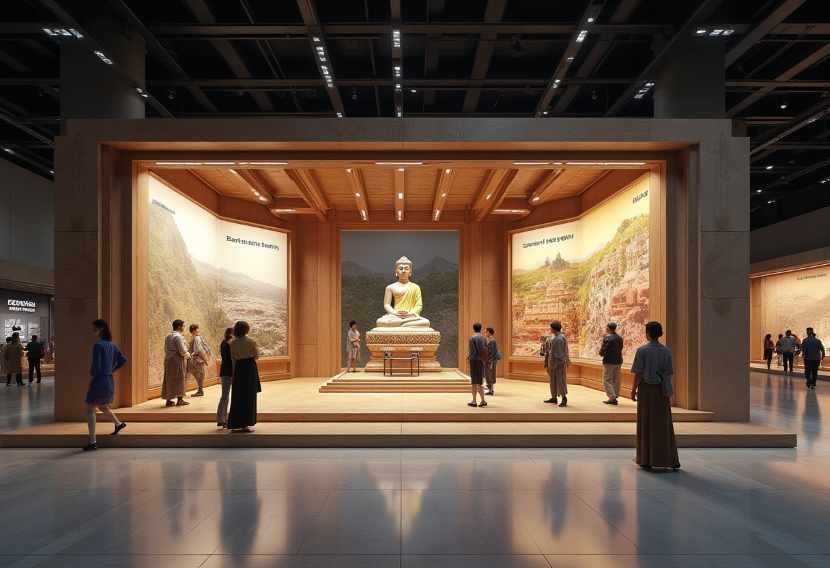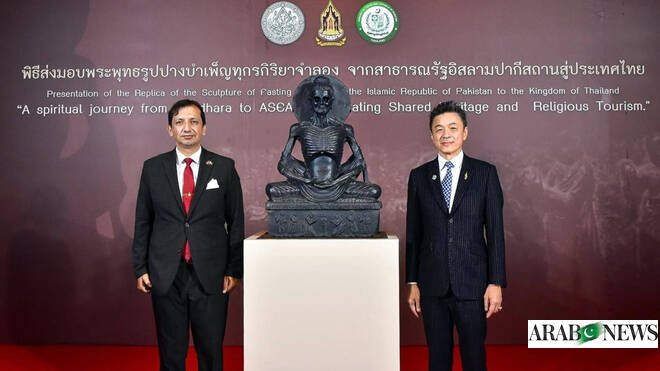Spiritual Travel
UP Govt Approves Rs 90 Crore Tourism Push For Naimisharanya; Focus On Temples, Corridors, Vedic Gateways

The Uttar Pradesh government has approved tourism projects worth Rs 90 crore to enhance infrastructure and religious tourism in Naimisharanya, Sitapur. Tourism Minister Jaiveer Singh stated that the Naimisharanya Development Council has cleared the proposals as part of a broader initiative to position the pilgrimage town on the global religious tourism map.
Under this plan, several major projects will be undertaken, including the construction of Toran gates at Rajghat in Misrikh on the Lucknow-Sitapur Road, themed around Vedic culture. Corridors will also be developed from Kalli Road Bypass to Rajghat via Lalita Devi Temple and Chakratirtha, and from Lalita Devi Temple to Rajghat via Kaliwadi Square.
Additionally, solar-powered street lights will be installed on main and connecting roads, multilingual information boards will be placed across the area, and a new cultural site, Vedaranyam, will be developed.
ALSO READ: Amit Shah Slams P Chidambaram Over ‘Homegrown Terrorist’ Remark: ‘Why Shield Pakistan?’ | Video
Religious sites like Golababa Temple (Jihura New Basti, Panchayat), Vrimhadev Dham (Udaipur West, Godlamau), and temples including Sidhauli Temple, Sabri Mata Temple, and Ramjanaki Temple are also included in the tourism development plan.
The comprehensive initiative aims to transform Naimisharanya into a spiritual and cultural destination of international repute.
Spiritual Travel
Uttar Pradesh Shines On Global Buddhist Stage At Busan Expo 2025: A Spiritual Journey From India To Korea

Saturday, August 2, 2025
Uttar Pradesh Tourism is preparing to make a major cultural statement on the international stage at the Busan International Buddhism Expo 2025, taking place from August 7 to 10, 2025, at BEXCO, in the bustling coastal city of Busan, South Korea. This pavilion will serve as a key initiative to showcase India’s spiritual and cultural heritage, specifically focusing on the ancient and profound history of Buddhism that began in India over 2,500 years ago.
This participation comes at a time when Uttar Pradesh, home to some of the most sacred and revered Buddhist sites in the world, is gaining increasing global attention as a destination for spiritual tourism. As the world’s largest gathering dedicated to Buddhism, the Busan Expo provides an unparalleled platform to bring the Buddhist Circuit of India into the global spotlight. The expo will showcase the rich history of Uttar Pradesh, highlighting landmarks such as Sarnath, Kushinagar, Shravasti, and Kaushambi, places that are crucial to understanding the life and teachings of Lord Buddha.
A Bridge Between India and Korea
The pavilion will be inaugurated by senior officials from the Embassy of India in South Korea, reaffirming the long-standing cultural and spiritual ties between India and South Korea. These relationships date back more than 2,500 years to the arrival of Buddhist teachings in Korea, with a notable connection being the journey of Princess Suriratna from Ayodhya (in Uttar Pradesh) to Korea, which solidified ties between the two nations. This deep-rooted historical and cultural connection serves as the foundation of India’s Buddhist diplomacy, and Uttar Pradesh’s participation in the Busan Expo 2025 represents a modern chapter in this enduring relationship.
The pavilion at the Busan International Buddhism Expo will reflect this heritage, with each element of the space designed to honor the sacred Buddhist sites of Uttar Pradesh, while also engaging visitors through innovative experiences such as virtual pilgrimages, 3D storytelling, and interactive displays. This allows visitors to experience the ancient places where Lord Buddha gave his first sermon and attained Mahaparinirvana, offering a new level of immersion and engagement in the Buddhist Circuit.
Uttar Pradesh’s Buddhist Legacy on Display
Uttar Pradesh, often regarded as the heart of India’s Buddhist heritage, is home to some of the most significant Buddhist sites in the world. The Sarnath site, where Lord Buddha delivered his first sermon to his first five disciples, is a major pilgrimage destination for Buddhists worldwide. Kushinagar, where Buddha passed away and attained Mahaparinirvana, holds immense religious significance, while Shravasti and Kaushambi are other key locations that tell the story of Buddha’s life and teachings.
These sites will be brought to life at the Busan Expo with multimedia storytelling, virtual tours, and a rich display of cultural artifacts, relics, and local handicrafts. Visitors will be able to see and engage with authentic representations of Buddhist relics and art that showcase the profound legacy of Uttar Pradesh’s Buddhist heritage. Additionally, the pavilion will provide detailed travel information, offering guidance and travel advisory services to potential international visitors who are interested in exploring the Buddhist Circuit of Uttar Pradesh.
Offering a Spiritual and Cultural Experience
The Uttar Pradesh Pavilion will also highlight the region’s rich and vibrant cultural heritage, which goes beyond Buddhism to encompass art, fashion, film, and cuisine. Visitors to the pavilion will not only have the opportunity to explore the Buddhist heritage of Uttar Pradesh but also experience the region’s dynamic cultural offerings through live performances, cooking demonstrations, and local handicraft displays. For instance, traditional music and dance performances will offer a window into the spiritual and cultural practices of the state, allowing visitors to understand how Buddhism has influenced art and culture in Uttar Pradesh for centuries.
This cultural showcase is designed to be immersive and interactive, using technology such as augmented reality and virtual reality to transport visitors to the heart of the Buddhist Circuit, and to allow them to witness the teachings and historical significance of these sites. Visitors will also have the chance to participate in meditation sessions, attend spiritual discussions, and engage in wellness activities inspired by the Buddhist traditions of Uttar Pradesh.
Strengthening India’s Cultural Diplomacy and Spiritual Tourism
By showcasing Uttar Pradesh’s Buddhist heritage at the Busan Expo, India is not only promoting its spiritual tourism offerings but also positioning itself as a global leader in cultural diplomacy. This initiative is in line with the Indian government’s broader goal to strengthen international relationships through spiritual tourism. The Expo’s global platform allows India to share its living Buddhist traditions and foster a deeper connection with spiritual seekers and travelers from across the world.
As South Korea continues to grow as a major outbound travel market, particularly for spiritual and wellness tourism, Uttar Pradesh is becoming an increasingly attractive destination. The Buddhist Circuit offers a powerful spiritual journey that not only attracts Buddhists but also resonates with modern travelers seeking mindful and spiritual experiences. By promoting Uttar Pradesh at a leading international exhibition like the Busan Expo, India is enhancing its visibility as a key destination for those seeking peace, reflection, and enlightenment.
The Role of Tourism in Global Buddhist Networks
In addition to spiritual and cultural diplomacy, Uttar Pradesh’s participation in the Busan Expo helps promote sustainable tourism in India. The state’s growing focus on eco-friendly practices and the development of tourism infrastructure will help manage the increased interest from international visitors. The state government is committed to preserving its rich cultural heritage while ensuring that tourism contributes to the local economy and provides jobs for local communities. This will further solidify Uttar Pradesh as a world-class destination for spiritual tourism.
Conclusion
The Uttar Pradesh Tourism Pavilion at the Busan International Buddhism Expo 2025 marks a pivotal step in the state’s efforts to showcase its rich Buddhist heritage and deepen its cultural connections with the global community. By offering a comprehensive spiritual and cultural experience, the pavilion will not only attract visitors to Uttar Pradesh but also bolster India’s position as a leader in Buddhist diplomacy and spiritual tourism. As the world increasingly looks for meaningful, mindful travel experiences, Uttar Pradesh is poised to be at the heart of these journeys, inviting travelers to walk the path of Dhamma and rediscover the spiritual legacy of India.
Spiritual Travel
UP Tourism set to shine on global Buddhist stage at Busan International Buddhism Expo 2025

In a significant step towards globalising India’s Buddhist heritage, Uttar Pradesh Tourism will unveil a grand pavilion at the upcoming Busan International Buddhism Expo 2025, scheduled to be held from August 7 to 10 at BEXCO, Busan, South Korea.
With a thoughtfully curated showcase, Uttar Pradesh will represent India’s spiritual and cultural legacy at one of Asia’s most prominent Buddhist gatherings.
Advertisement
The pavilion will be inaugurated by senior officials from the Embassy of India in South Korea. It will serve as a tribute to the civilisational connection between India and Korea, highlighting the deep spiritual bond that began with the teachings of Lord Buddha over 2,500 years ago.
Uttar Pradesh is home to some of the most sacred sites in the Buddhist world, including Sarnath, where Lord Buddha delivered his first sermon, and Kushinagar, where he attained Mahaparinirvana. The state will also showcase Shravasti, Sankisa, and Kaushambi, which hold immense spiritual and archaeological importance.
Each segment of the pavilion will offer an interactive experience, featuring virtual pilgrimages, 3D storytelling, authentic cultural artefacts, and travel advisory services for Korean and international visitors interested in exploring the Buddhist Circuit of Uttar Pradesh.
“Uttar Pradesh is not just the land of temples and traditions. It is the land where the Buddha gave the world his first sermon and where his journey of peace concluded. Through this global platform, we will invite the world to rediscover India through the path of Dhamma,” said Jaiveer Singh, UP Minister of Tourism and Culture, here on Saturday.
The 2025 edition of the Busan Expo is expected to witness significant growth, with around 375 booths featuring meditation experiences, Buddhist art, wellness programmes, and interactive learning spaces. This year’s theme, ‘Find Your Enlightenment (with the Eightfold Path),’ is designed to appeal to a global audience, particularly Western youth and modern spiritual seekers.
Uttar Pradesh Tourism’s participation will align with this forward-looking theme by offering immersive storytelling, spiritual exploration, and a glimpse into India’s living Buddhist traditions.
“By showcasing our rich Buddhist legacy in an international and engaging format, we aim to strengthen India’s cultural diplomacy and make spiritual tourism more relevant to today’s generation. Our goal is for Korean visitors to see Uttar Pradesh not just as a destination but as a spiritual home,” said Mukesh Kumar Meshram, Principal Secretary, Department of Tourism.
India and South Korea share centuries of Buddhist and cultural connections, from the legendary journey of Princess Suriratna from Ayodhya to Korea to the ongoing exchange of spiritual ideas and traditions. Uttar Pradesh’s presence at the Busan Expo will reinforce India’s leadership in Buddhist diplomacy and serve as a platform for promoting peace, understanding, and tourism.
This initiative will also be a part of India’s broader efforts to promote the Buddhist Circuit as a world-class tourism offering, supported by modern infrastructure, digital storytelling, and strong international partnerships.
As South Korea emerges as a leading outbound travel market with a growing interest in spiritual and wellness tourism, Uttar Pradesh’s participation in Busan will help position it as a preferred destination for mindful travellers and cultural explorers.
The UP Tourism pavilion will remain open to visitors from August 7 to 10, inviting them to walk the path of the Buddha and discover the spiritual heart of India.
Spiritual Travel
Pakistan gifts Fasting Buddha replica to Thailand to boost cultural ties, religious tourism

ISLAMABAD/NEW DELHI: Just after midnight on May 7, the screen in the Pakistan Air Force’s operations room lit up in red with the positions of dozens of active enemy planes across the border in India.
Air Chief Mshl. Zaheer Sidhu had been sleeping on a mattress just off that room for days in anticipation of an Indian assault.
New Delhi had blamed Islamabad for backing militants who carried out an attack the previous month in Indian-administered Kashmir, which killed 26 civilians. Despite Islamabad denying any involvement, India had vowed a response, which came in the early hours of May 7 with air strikes on Pakistan.
Sidhu ordered Pakistan’s prized Chinese-made J-10C jets to scramble. A senior Pakistani Air Force (PAF) official, who was present in the operations room, said Sidhu instructed his staff to target Rafales, a French-made fighter that is the jewel of India’s fleet and had never been downed in battle.
“He wanted Rafales,” said the official.
The hour-long fight, which took place in darkness, involved some 110 aircraft, experts estimate, making it the world’s largest air battle in decades. The J-10s shot down at least one Rafale, Reuters reported in May, citing US officials. Its downing surprised many in the military community and raised questions about the effectiveness of Western military hardware against untested Chinese alternatives. Shares of Dassault, which makes the Rafale, dipped after reports the fighter had been shot down. Indonesia, which has outstanding Rafale orders, has said it is now considering purchasing J-10s – a major boost to China’s efforts to sell the aircraft overseas.
But Reuters interviews with two Indian officials and three of their Pakistani counterparts found that the performance of the Rafale wasn’t the key problem: Central to its downing was an Indian intelligence failure concerning the range of the
China-made PL-15 missile fired by the J-10 fighter. China and Pakistan are the only countries to operate both J-10s, known as Vigorous Dragons, and PL-15s.
The faulty intelligence gave the Rafale pilots a false sense of confidence they were out of Pakistani firing distance, which they believed was only around 150 km, the Indian officials said, referring to the widely cited range of PL-15’s export variant.
“We ambushed them,” the PAF official said, adding that Islamabad conducted an electronic warfare assault on Delhi’s systems in an attempt to confuse Indian pilots. Indian officials dispute the effectiveness of those efforts.
“The Indians were not expecting to be shot at,” said Justin Bronk, air warfare expert at London’s Royal United Services Institute (RUSI) think-tank. “And the PL-15 is clearly very capable at long range.”
The PL-15 that hit the Rafale was fired from around 200km (124.27 mi) away, according to Pakistani officials, and even farther according to Indian officials. That would make it among the longest-range air-to-air strikes recorded.
India’s defense and foreign ministries did not return requests for comment about the intelligence mistakes. Delhi hasn’t acknowledged a Rafale being shot down, but France’s air chief told reporters in June that he had seen evidence of the loss of that fighter and two other aircraft flown by India, including a Russian-made Sukhoi. A top Dassault executive also told French lawmakers that month that India had lost a Rafale in operations, though he didn’t have specific details.
Pakistan’s military referred to past comments by a spokesperson who said that its professional preparedness and resolve was more important than the weaponry it had deployed. China’s defense ministry did not respond to Reuters’ questions. Dassault and UAC, the manufacturer of the Sukhoi, also did not return requests for comment.
“SITUATIONAL AWARENESS”
Reuters spoke to eight Pakistani and two Indian officials to piece together an account of the aerial battle, which marked the start of four days of fighting between the two nuclear-armed neighbors that caused alarm in Washington. The officials all spoke on condition of anonymity to discuss national security matters.
Not only did Islamabad have the element of surprise with its missiles’ range, the Pakistani and Indian officials said, but it managed to more efficiently connect its military hardware to surveillance on the ground and in the air, providing it with a clearer picture of the battlefield. Such networks, known as “kill chains,” have become a crucial element of modern warfare.
Four Pakistani officials said they created a “kill chain,” or a multi-domain operation, by linking air, land and space sensors. The network included a Pakistani-developed system, Data Link 17, which connected Chinese military hardware with other equipment, including a Swedish-made surveillance plane, two Pakistani officials said.
The system allowed the J-10s flying closer to India to obtain radar feeds from the surveillance plane cruising further away, meaning the Chinese-made fighters could turn their radars off and fly undetected, according to experts. Pakistan’s military did not respond to requests for comment on this point.
Delhi is trying to set up a similar network, the Indian officials said, adding that their process was more complicated because the country sourced aircraft from a wide range of exporters.
Retired UK Air Mshl. Greg Bagwell, now a fellow at RUSI, said the episode didn’t conclusively prove the superiority of either Chinese or Western air assets but it showed the importance of having the right information and using it.
“The winner in this was the side that had the best situational awareness,” said Bagwell.
CHANGE IN TACTICS
After India in the early hours of May 7 struck targets in Pakistan that it called “terrorist infrastructure,” Sidhu ordered his squadrons to switch from defense to attack.
Five PAF officials said India had deployed some 70 planes, which was more than they had expected and provided Islamabad’s PL-15s with a target-rich environment. India has not said how many planes were used.
The May 7 battle marked the first big air contest of the modern era in which weaponry is used to strike targets beyond visual range, said Bagwell, noting both India and Pakistan’s planes remained well within their airspaces across the duration of the fight.
Five Pakistani officials said an electronic assault on Indian sensors and communications systems reduced the situational awareness of the Rafale’s pilots.
The two Indian officials said the Rafales were not blinded during the skirmishes and that Indian satellites were not jammed. But they acknowledged that Pakistan appeared to have disrupted the Sukhoi, whose systems Delhi is now upgrading.
Other Indian security officials have deflected questions away from the Rafale, a centerpiece of India’s military modernization, to the orders given to the air force.
India’s defense attaché in Jakarta told a university seminar that Delhi had lost some aircraft “only because of the constraint given by the political leadership to not attack (Pakistan’s) military establishments and their air defenses.”
India’s chief of defense staff Gen. Anil Chauhan previously told Reuters that Delhi quickly “rectified tactics” after the initial losses.
After the May 7 air battle, India began targeting Pakistani military infrastructure and asserting its strength in the skies. Its Indian-made BrahMos supersonic cruise missile repeatedly sliced through Pakistan’s air defenses, according to officials on both sides.
On May 10, India said it struck at least nine air bases and radar sites in Pakistan. It also hit a surveillance plane parked in a hangar in southern Pakistan, according to Indian and Pakistani officials. A ceasefire was agreed later that day, after
US officials held talks with both sides.
‘LIVE INPUTS’
In the aftermath of the episode, India’s deputy army chief Lt. Gen. Rahul Singh accused Pakistan of receiving “live inputs” from China during the battles, implying radar and satellite feeds. He did not provide evidence and Islamabad denies the allegation.
When asked at a July briefing about Beijing’s military partnership with Pakistan, Chinese Foreign Ministry spokesperson Mao Ning told reporters the work was “part of the normal cooperation between the two countries and does not target any third party.”
Beijing’s air chief Lt. Gen. Wang Gang visited Pakistan in July to discuss how Islamabad had used Chinese equipment to put together the “kill chain” for the Rafale, two PAF officials said.
China did not respond when asked about that interaction. The Pakistani military said in a statement in July that Wang had expressed “keen interest in learning from PAF’s battle-proven experience in Multi Domain Operations.”
-

 Brand Stories2 weeks ago
Brand Stories2 weeks agoBloom Hotels: A Modern Vision of Hospitality Redefining Travel
-

 Brand Stories1 week ago
Brand Stories1 week agoCheQin.ai sets a new standard for hotel booking with its AI capabilities: empowering travellers to bargain, choose the best, and book with clarity.
-

 Destinations & Things To Do2 weeks ago
Destinations & Things To Do2 weeks agoUntouched Destinations: Stunning Hidden Gems You Must Visit
-

 Destinations & Things To Do1 week ago
Destinations & Things To Do1 week agoThis Hidden Beach in India Glows at Night-But Only in One Secret Season
-

 AI in Travel2 weeks ago
AI in Travel2 weeks agoAI Travel Revolution: Must-Have Guide to the Best Experience
-

 Brand Stories4 weeks ago
Brand Stories4 weeks agoVoice AI Startup ElevenLabs Plans to Add Hubs Around the World
-

 Brand Stories3 weeks ago
Brand Stories3 weeks agoHow Elon Musk’s rogue Grok chatbot became a cautionary AI tale
-

 Asia Travel Pulse4 weeks ago
Asia Travel Pulse4 weeks agoLooking For Adventure In Asia? Here Are 7 Epic Destinations You Need To Experience At Least Once – Zee News
-

 AI in Travel4 weeks ago
AI in Travel4 weeks ago‘Will AI take my job?’ A trip to a Beijing fortune-telling bar to see what lies ahead | China
-

 Brand Stories4 weeks ago
Brand Stories4 weeks agoChatGPT — the last of the great romantics





You must be logged in to post a comment Login